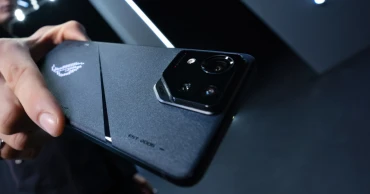ROG Phone
Asus ROG Phone 8 Pro Review: A High-end Gaming Device
The Asus ROG Phone 8 Pro debuted in India on January 08, 2024, and people are wondering if it's still a gaming phone. Unlike the ancestors, this new model looks quite different. Even with the new look, the 8 Pro keeps its focus on gaming without making things complicated. However, this flagship smartphone's performance has changed a bit though. The previous ROG phones used to work like a gaming PC. Interestingly, the latest 8 Pro serves in simpler and easier ways like a PlayStation. Let’s take a look at the detailed review of the Asus ROG Phone 8 Pro.
Key Features and Specifications of ROG Phone 8 Pro
Design
The ROG Phone 8 Pro brings some notable changes to the table, introducing an edge-to-edge screen that enhances its aesthetic appeal. However, this design shift comes with trade-offs, such as the removal of dual front-facing speakers, impacting the immersive gaming experience.
The incorporation of a pinhole camera in the screen raises concerns for a gaming device, disrupting the seamless display. Despite losing some distinctive features that set the ROG Phone apart, it retains the headphone jack and gains an IP68 rating, a positive addition given its open ports. The transition from a glass to a plastic back raises concerns about slipperiness, emphasising the need for a protective case.
Read more: Asus ROG Strix G16 Review: Is it a value for money gaming laptop?
The device maintains its off-centre USB-C, but a secondary USB-C on the side proves handy for charging during portrait-mode gaming. Notably, the pixel-like LED effects on the back, customizable to display various information, provide a unique touch and contribute positively to the gaming aesthetics, standing out from typical RGB implementations.
Weighing 225g, 8 Pro’s dimensions are 163.8 mm by 76.8 mm by 8.9 mm. It is available in Phantom Black colour.
Display
The ROG Phone 8 Pro maintains a 6.78-inch FHD OLED display protected by Corning Gorilla Glass Victus 2. It features 2,500 nits of peak brightness
It lacks the QHD resolution seen in the contemporary Android flagships. The display supports an adaptive 1-120Hz refresh rate for regular use, with a fixed 165Hz rate for specific games, enhancing smoothness during gameplay.
Read more: Asus ROG Phone 8 Review: 2024’s First Flagship Gaming Device
In comparison to the Samsung Galaxy S23 Ultra, the ROG Phone 8 Pro excels in key metrics/ However, 8 Pro faces tough competition from the iPhone 15 Pro Max, which offers remarkable brightness and color accuracy.
Notably, the ROG Phone 8 introduces a unique always-on display called Screen Light, utilizing tiny icons for charging status and essential information due to the absence of a thick top bezel. While functional, there's room for improvement, such as a scaling feature for better readability from a distance.
1 year ago
Asus ROG Phone 8 Review: 2024’s First Flagship Gaming Device
Known for producing top-notch Android gaming phones under the ROG line-up, Asus has distinguished itself by creating purpose-built devices. In this wave, the Asus ROG Phone 8 made its debut at the Consumer Electronics Show (CES) 2024 on January 8. Let’s take a look at the new features and upgrades in the latest ROG phone.
Key Features and Specs of ROG Phone 8
Design
The Asus ROG Phone 8 Pro introduces a more conventional design, weighing 225 grams and measuring 163.8mm by 76.8mm by 8.9 mm. With smaller bezels and a thinner 8.9mm profile, it offers a lighter and sleeker form factor.
Retaining AirTriggers on each shoulder, the phone forgoes motorised vents, gaining an IP68 water and dust resistance rating. Practical features like the 3.5mm headphone jack and side-mounted USB-C charging port remain intact.
Read more: Apple’s 2024 Line-up: A leap into the future with Vision Pro, OLED iPad Pro, and more
While still gaming-centric, the ROG Phone 8 Pro deviates from the bold aesthetics of its predecessors. The rear panel conceals the LED array when turned off, giving it a more ordinary appearance. Even the camera module adopts a simple, slightly raised square section in the top corner.
However, users may find it less striking compared to previous models. The design, seemingly aimed at broader appeal and usability, may risk alienating hardcore ROG Phone enthusiasts who appreciate the uniqueness of older models.
ROG Phone 8 is available in two colour options: Rebel Grey and Phantom Black.
Display
The Asus ROG Phone 8 boasts a 6.78-inch FHD+ (2400 by 1080 pixels) Samsung Flexible AMOLED display. The screen is protected by Corning Gorilla Glass Victus 2. With a vivid colour range, it covers 107.37% DCI-P3, 145.65% sRGB, and 103.16% NTSC colour gamuts. This means sharp and vibrant visuals.
Read more: Apple's Vision Pro Headset: Everything You Need to Know
The brightness is impressive, reaching up to 1,600 nits HBM and a peak brightness of 2,500 nits. HDR10 support enhances the viewing experience, providing richer colours and contrast. The display offers a variable refresh rate from 1Hz to 120Hz, with a maximum of 165Hz for supported games, ensuring smooth visuals.
Noteworthy is the Always-On display feature, displaying essential information with tiny icons, like charging status, due to the absence of a thick top bezel. The 10-point multitouch supports glove touch, adding to user convenience.
While some may miss a QHD resolution, the FHD choice is likely a compromise for better power consumption, especially with the phone's higher refresh rate. Overall, the Asus ROG Phone 8's display promises an immersive and dynamic visual experience.
Read more: iQOO Neo 9 Review: A Flagship Grade Mid-Range Smartphone
Cameras
The Asus ROG Phone 8 comes equipped with a powerful rear camera setup for capturing stunning photos and videos. The main rear camera features a Sony IMX 890 50 MP image sensor with a large 1/1.56” sensor size.
Enhancing stability, the main camera incorporates Gimbal OIS (Optical Image Stabilization) and Quad Bayer technology, resulting in a 12.5 MP image with a 2 µm large effective pixel size. The wide F1.9 aperture and a 23.8mm equivalent focal length in a 35mm film camera ensure impressive low-light performance and sharp images.
Complementing the main camera is a 13 MP second rear camera with a 120° ultrawide-angle lens and a Free-form lens, providing diverse shooting perspectives. The equivalent focal length is 12.7mm in a 35mm film camera.
Read more: realme GT5 Pro Review: High-performance or Hype?
Adding versatility, the third rear camera is a 32 MP lens with f/2.4 aperture, OIS, and 3X optical zoom. Utilising pixel binning technology, the actual output photo is 8 MP, and the equivalent focal length in a 35mm film camera is 65.3mm.
For selfie enthusiasts, the front camera boasts a 32 MP RGBW sensor with pixel binning for 1.4μm size (actual output photo: 8 MP). The equivalent focal length in a 35mm film camera is 22mm, ensuring clear and vibrant self-portraits. Overall, the camera setup on the Asus ROG Phone 8 promises a versatile and high-quality photography experience.
1 year ago
Asus ROG Phone 6D Review: Worth the price tag?
Since 2006, Asus has marketed a variety of PC gaming-focused computer hardware, personal computers, and accessories under the name of Republic of Gamers (ROG). With the three distinct ultrasonic AirTrigger touch sensors, the ROG Phones provide a more console-like gaming experience. ASUS brings its latest innovation ROG Phone 6D in September of 2022. Besides a gaming friendly design and smart interior architecture, this high-end gaming phone is blessed with a robust processor and advanced cooling technologies. Let’s take a look at the key features, pros and cons of Asus ROG Phone 6D.
Key specifications of Asus ROG Phone 6D
Design
The ROG Phone 6D has certain similarities with earlier models. It is a large, cumbersome smartphone (173 x 77 x 10.4 mm) that is comfortably taller and wider than the iPhone 14 Pro Max (160.7 x 77.6 x 7.9 mm). It requires two hands to operate and occupies much pocket space.
Asus attempts to mitigate this weight (239g) somewhat by curving the glass on the back panel so that it is at least somewhat pleasant to hold. Nevertheless, several characteristics indicate that it is mainly intended for using two hands in the landscape.
Read Apple's iPhone 14 Review: A revamped iPhone 13?
In ROG Phone 6D, Asus offers the ‘AeroActive Portal,’ a tiny mechanical duct on the back of the device that opens automatically when the AeroActive cooling fan is attached. With this channel open, the fan can push cool air directly into the phone's body while simultaneously dispersing heat from the back glass, allowing the device to run optimally for extended periods.
Its front panel is built with Corning Gorilla Glass Victus; where the back panel features Gorilla Glass construction. The device is built with an aluminum frame. In this device, water splash protection is provided by IPX4 from all directions.
Display
Asus ROG Phone 6D sports Samsung AMOLED display with a large screen (6.78" ). Its 2448 x 1080p resolution offers adequate sharpness to offer clear and detailed visuals. The display offers a great deal of vibrancy and brightness (~395 ppi density).
Read Top 10 free Flight Simulator games for PC, laptop
Gamers can comfortably play virtual games in broad daylight in outdoor ambiences. In addition, it has a practical aspect ratio (20.4:9), which makes it perfect for movies and video games. The display is fully flat, which means that there is no distortion at the borders of the screen.
ROG Phone 6D supports HDR10+. With this phone, users can watch contents from diverse streaming services with significant contrast and an excellent peak brightness level. You will never have the impression that the colors will get over the top, even though the picture will normally be extremely saturated. Beyond gaming, this phone is also great for media consumption.
It is also possible for refresh rates to reach a maximum of 165 hertz in ROG Phone 6D. Although unnecessary for most applications and services, it ensures that scrolling interfaces and games with enhanced refresh capabilities may be played without issue.
Read Oppo A57 Review: Key specs, pros and cons
Rear Cameras
Sony® flagship IMX 766 50 MP image sensor with a 1/1.56" big sensor size and 1 m pixel size is used as the primary rear camera. This 35mm film camera comes with F1.9 aperture and 23.8mm equivalent focal length. The primary sensor is the same as that of the ROG Phone 6, ZenFone 9, and Oppo Find X5 Pro. This sensor operates well in well-lit circumstances, producing vibrant and vivid images in clear daylight. In general, colors are highly enhanced, although not to an extreme degree of hyperrealism. They give photos "pop," making them perfect for contemporary preferences.
Second rear camera features a 13 MP, ultrawide-angle sensor featuring 12.5 mm equivalent focal length in a 35mm film camera. The Third Rear Camera is a 5 MP Macro sensor; however it should not be held in especially high regard.
Video Recording
The maximum recording quality of its main rear camera is 8K UHD (7680 x 4320) footage at 24 frames per second (Only support H.265), or 4K UHD (3840 x 2160) footage at 30/ 60 frames per second.
Read Vivo V25 Pro: Detailed Review with Key Specifications
The second rear camera is capable of 4K UHD (3840 x 2160) footage at 30 frames per second or 1080p FHD video recording at 30 / 60 frames per second. You can also record 720p HD video footage at 30/60 frames per second. Its primary 50MP and ultra-wide 13MP cameras can shoot in 4K UHD with HDR10+.
Moreover, the back sensors of ROG Phone 6D provides camera 3-axis electronic image stabilization. The time-lapse feature is available for shooting a 4K UHD video. Slow motion videos can be done for recording 1080p footage at 240/120 frames per second or 720p footage at 480 frames per second. While filming a video, this device allows you to take a still picture.
Front Camera
The front 12-megapixel camera has 27.5mm equivalent lens length. This 35mm film camera shoots respectable selfies. However, its performance deteriorates as the light decreases. It offers a portrait mode with adequate edge recognition. Nevertheless, the overall performance is satisfactory, and casual users will be pleased with the outcomes.
Read International Roaming: How to use a Bangladeshi SIM card abroad
Performance
This phone's hardware specifications are almost identical to other pro-level devices. The ROG Phone 6D is powered by the most recent Snapdragon 8+ Gen 1 combined with Mediatek Dimensity 9000+ CPU and Mali-G710 GPU. This phone is equipped with a huge 16GB of RAM and 512GB of storage space.
While watching games or media, the users may often experience that the top portion of a phone becomes heated since that's where the main hardware is located. Heating issues are typical in many phones, when the device is used for an extended period.
Thanks to Asus for making the ROG Phone 6D’s interior design is a little special as a gaming phone. Asus has split the battery and placed the processor in the middle of the device. This implies that the battery is not concentrated on one end like other regular phones. This special architecture is meant to allow for improved cooling; so that if the device gets heated up, you won't feel it beneath your fingertips while gaming.
Read Price Drop: Is it the right time to buy an iPhone 13?
Battery Life
Asus ROG Phone 6D is blessed with a high-capacity battery with an equivalent capacity of 6000 mAh that supports PD Charging.
The battery capacity of the ROG Phone 6D is split between two symmetrical cells, each of which has a capacity of 3000 mAh. The decision to divide the cells was taken for a few different reasons: first, to distribute the battery's significant weight more equally; second, to reduce the amount of heat generated while it is being used and when it is being charged.
Price of Asus ROG Phone 6D
The Asus ROG Phone 6D hasn't officially been launched in India or Bangladesh, and however, the phone is unofficially available in both countries at special rates. In India, the phone charges around INR 59,999, meaning the unofficial Bangladeshi version will charge around BDT 75,000. The conversion rate here is 1 INR = 1.24 BDT.
Read Xiaomi Mi Smart Projector 2 Review: Watch FIFA World Cup on 120 inch Screen
Conclusion
The ROG Phone 6D is a monster of a phone, filled with features that appeal primarily to gamers while providing a fantastic experience for regular users. The look is a little eccentric, but if you spend a lot of time gaming on your phone, the ROG Phone provides substantial benefits.
The phone has Qualcomm's flagship Snapdragon 8+ Gen 1 processor along with Mediatek Dimensity 9000 chipset. It is loaded with an array of powerful cooling and control capabilities typical of ASUS gaming smartphones. In addition to a superior display, enough processing power, speakers, and software enhancements are designed to improve your gaming experience. It seems that the Taiwanese powerhouse Asus has opted to streamline its portfolio for the current year. ROG Phone 6D seems to be an intriguing option for the most avid mobile gamers due to its extensive features.
However, for this ROG Phone, Asus offers only two years of software upgrades facility, which can be a drawback. The camera configuration of this latest Asus gaming phone is not much advanced. Other than that, you would be pleased to utilize the Asus ROG Phone 6D constantly.
Read Xiaomi Redmi 11 Prime Review: Performance at a budget price
3 years ago





